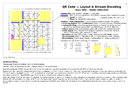| Revision as of 13:42, 18 June 2014 view sourceDiscospinster (talk | contribs)Administrators466,213 editsm Reverted edits by 204.184.17.103 (talk) to last revision by Aoidh (HG)← Previous edit | Revision as of 13:43, 18 June 2014 view source 204.184.17.103 (talk) →UsesNext edit → | ||
| Line 25: | Line 25: | ||
| == Uses == | == Uses == | ||
| Originally designed for industrial uses, QR codes have become common in consumer advertising. Typically, a ] is used as a QR code scanner, displaying the code and converting it to some useful form (such as a standard ] for a website, thereby obviating the need for a user to type it into a ]).] | Money bags Originally designed for industrial uses, QR codes have become common in consumer advertising. Typically, a ] is used as a QR code scanner, displaying the code and converting it to some useful form (such as a standard ] for a website, thereby obviating the need for a user to type it into a ]).] | ||
| "In the shopping industry, knowing what causes the consumers to be motivated when approaching products by the use of QR codes, advertisers and marketers can use the behavior of scanning to get consumers to buy, causing it to have the best impact on ad and marketing design."<ref>{{cite journal | author = Tolliver-Walker, Heidi | year = 2011 | title = Making Best Use of QR codes: Gleaning Lessons from the Latest Data | url = | journal = Seybold Report: Analyzing Publishing Technologies | volume = 11 | issue = 23 | pages = 2–7 }}</ref> As a result, the QR code has become a focus of ] strategy, since it provides quick and effortless access to the brand's website.<ref>{{cite web |url=http://www.mobilemarketer.com/cms/news/software-technology/11930.html |title=http://www.mobilemarketer.com/cms/news/software-technology/11930.html |archiveurl=http://archive.is/20120912/http://www.mobilemarketer.com/cms/news/software-technology/11930.html |archivedate=2012-09-12}}</ref><ref>{{cite web |url=http://blogs.vancouversun.com/2012/01/04/tescos-cool-qr-code-advertising-campaign/ |title=http://blogs.vancouversun.com/2012/01/04/tescos-cool-qr-code-advertising-campaign/ |archiveurl=http://archive.is/20120720/http://blogs.vancouversun.com/2012/01/04/tescos-cool-qr-code-advertising-campaign/ |archivedate=2012-07-20}}</ref> Beyond mere convenience to the consumer, the importance of this capability is that it increases the ] (that is, it increases the chance that contact with the advertisement will convert to a sale), by coaxing interested prospects further down the ] without any delay or effort, bringing the viewer to the advertiser's website immediately, where a longer and more targeted sales pitch may continue. | "In the shopping industry, knowing what causes the consumers to be motivated when approaching products by the use of QR codes, advertisers and marketers can use the behavior of scanning to get consumers to buy, causing it to have the best impact on ad and marketing design."<ref>{{cite journal | author = Tolliver-Walker, Heidi | year = 2011 | title = Making Best Use of QR codes: Gleaning Lessons from the Latest Data | url = | journal = Seybold Report: Analyzing Publishing Technologies | volume = 11 | issue = 23 | pages = 2–7 }}</ref> As a result, the QR code has become a focus of ] strategy, since it provides quick and effortless access to the brand's website.<ref>{{cite web |url=http://www.mobilemarketer.com/cms/news/software-technology/11930.html |title=http://www.mobilemarketer.com/cms/news/software-technology/11930.html |archiveurl=http://archive.is/20120912/http://www.mobilemarketer.com/cms/news/software-technology/11930.html |archivedate=2012-09-12}}</ref><ref>{{cite web |url=http://blogs.vancouversun.com/2012/01/04/tescos-cool-qr-code-advertising-campaign/ |title=http://blogs.vancouversun.com/2012/01/04/tescos-cool-qr-code-advertising-campaign/ |archiveurl=http://archive.is/20120720/http://blogs.vancouversun.com/2012/01/04/tescos-cool-qr-code-advertising-campaign/ |archivedate=2012-07-20}}</ref> Beyond mere convenience to the consumer, the importance of this capability is that it increases the ] (that is, it increases the chance that contact with the advertisement will convert to a sale), by coaxing interested prospects further down the ] without any delay or effort, bringing the viewer to the advertiser's website immediately, where a longer and more targeted sales pitch may continue. | ||
Revision as of 13:43, 18 June 2014
Not to be confused with Quadratic residue code.
QR code (abbreviated from Quick Response Code) is the trademark for a type of matrix barcode (or two-dimensional barcode) first designed for the automotive industry in Japan. A barcode is a machine-readable optical label that contains information about the item to which it is attached. A QR code uses four standardized encoding modes (numeric, alphanumeric, byte / binary, and kanji) to efficiently store data; extensions may also be used.
The QR Code system has become popular outside the automotive industry due to its fast readability and greater storage capacity compared to standard UPC barcodes. Applications include product tracking, item identification, time tracking, document management, general marketing, and much more.
A QR code consists of black modules (square dots) arranged in a square grid on a white background, which can be read by an imaging device (such as a camera) and processed using Reed–Solomon error correction until the image can be appropriately interpreted. The required data are then extracted from patterns present in both horizontal and vertical components of the image.
History
The QR code system was invented in 1994 by Denso Wave. Its purpose was to track vehicles during manufacture; it was designed to allow high-speed component scanning. Although initially used for tracking parts in vehicle manufacturing, QR codes now are used in a much broader context, including both commercial tracking applications and convenience-oriented applications aimed at mobile-phone users (termed mobile tagging). QR codes may be used to display text to the user, to add a vCard contact to the user's device, to open a Uniform Resource Identifier (URI), or to compose an e-mail or text message. Users can generate and print their own QR codes for others to scan and use by visiting one of several paid and free QR code generating sites or apps. The technology has since become one of the most-used types of two-dimensional barcode.
Standards

There are several standards that cover the encoding of data as QR codes:
- October 1997 – AIM (Association for Automatic Identification and Mobility) International
- January 1999 – JIS X 0510
- June 2000 – ISO/IEC 18004:2000 Information technology – Automatic identification and data capture techniques – Bar code symbology – QR code (now withdrawn)
Defines QR code models 1 and 2 symbols. - 1 September 2006 – ISO/IEC 18004:2006 Information technology – Automatic identification and data capture techniques – QR code 2005 bar code symbology specification
Defines QR code 2005 symbols, an extension of QR code model 2. Does not specify how to read QR code model 1 symbols, or require this for compliance.
At the application layer, there is some variation between most of the implementations. Japan's NTT DoCoMo has established de facto standards for the encoding of URLs, contact information, and several other data types. The open-source "ZXing" project maintains a list of QR code data types.
Uses
Money bags Originally designed for industrial uses, QR codes have become common in consumer advertising. Typically, a smartphone is used as a QR code scanner, displaying the code and converting it to some useful form (such as a standard URL for a website, thereby obviating the need for a user to type it into a web browser).

"In the shopping industry, knowing what causes the consumers to be motivated when approaching products by the use of QR codes, advertisers and marketers can use the behavior of scanning to get consumers to buy, causing it to have the best impact on ad and marketing design." As a result, the QR code has become a focus of advertising strategy, since it provides quick and effortless access to the brand's website. Beyond mere convenience to the consumer, the importance of this capability is that it increases the conversion rate (that is, it increases the chance that contact with the advertisement will convert to a sale), by coaxing interested prospects further down the conversion funnel without any delay or effort, bringing the viewer to the advertiser's website immediately, where a longer and more targeted sales pitch may continue.
Although initially used to track parts in vehicle manufacturing, QR codes are now (as of 2012) used over a much wider range of applications, including commercial tracking, entertainment and transport ticketing, product/loyalty marketing (examples: mobile couponing where a company's discounted and percent discount can be captured using a QR code decoder which is a mobile app, or storing a company's information such as address and related information alongside its alpha-numeric text data as can be seen in Yellow Pages directory), and in-store product labeling. It can also be used in storing personal information for use by organizations. An example of this is Philippines National Bureau of Investigation (NBI) where NBI clearances now come with a QR code. Many of these applications target mobile-phone users (via mobile tagging). Users may receive text, add a vCard contact to their device, open a Uniform Resource Identifier (URI), or compose an e-mail or text message after scanning QR codes. They can generate and print their own QR codes for others to scan and use by visiting one of several pay or free QR code-generating sites or apps. Google had a popular API to generate QR codes, and apps for scanning QR codes can be found on nearly all smartphone devices.
QR codes storing addresses and Uniform Resource Locators (URLs) may appear in magazines, on signs, on buses, on business cards, or on almost any object about which users might want information. Users with a camera phone equipped with the correct reader application can scan the image of the QR code to display text, contact information, connect to a wireless network, or open a web page in the telephone's browser. This act of linking from physical world objects is termed hardlinking or object hyperlinking. QR codes also may be linked to a location to track where a code has been scanned. Either the application that scans the QR code retrieves the geo information by using GPS and cell tower triangulation (aGPS) or the URL encoded in the QR code itself is associated with a location.
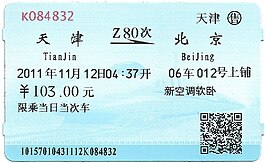
Recruiters have started placing QR codes in job advertisements, while applicants have started sporting it in their CVs and visiting cards.
In June 2011, The Royal Dutch Mint (Koninklijke Nederlandse Munt) issued the world's first official coin with a QR code to celebrate the centenary of its current building and premises. The coin can be scanned by a smartphone and link to a special website with contents about the historical event and design of the coin. In 2008, a Japanese stonemason announced plans to engrave QR codes on gravestones, allowing visitors to view information about the deceased, and family members to keep track of visits.
Mobile operating systems
QR codes can be used in Google's Android, BlackBerry OS, Nokia Symbian Belle, Apple iOS devices (iPhone/iPod/iPad), Microsoft Windows Phone, Google Goggles, 3rd party barcode scanners, and the Nintendo 3DS. The browser supports URL redirection, which allows QR codes to send metadata to existing applications on the device. mbarcode is a QR code reader for the Maemo operating system. In Apple's iOS, a QR code reader is not natively included, but more than fifty paid and free apps are available with both the ability to scan the codes and hard-link to an external URL. Google Goggles is an example of one of many applications that can scan and hard-link URLs for iOS and Android. BlackBerry 10 devices have a native QR reader as well as several third party readers. Windows Phone 7.5 is able to scan QR codes through the Bing search app's feature called Bing Vision.
URLs
URLs aided marketing conversion rates even in the pre-smartphone era, but during those years faced several limitations: ad viewers usually had to type the URL and often did not have a web browser in front of them at the moment they viewed the ad. The chances were high that they would forget to visit the site later, not bother to type a URL, or forget what URL to type. Clean URLs decreased these risks but did not eliminate them. Some of these disadvantages to URL conversion rates are fading away now that smartphones are putting web access and voice recognition in constant reach. Thus an advert viewer need only reach for his or her phone and speak the URL, at the moment of ad contact, rather than remember to type it into a PC later.
Virtual stores
During the month of June 2011, according to one study, 14 million mobile users scanned a QR code or a barcode. Some 58% of those users scanned a QR or barcode from their homes, while 39% scanned from retail stores; 53% of the 14 million users were men between the ages of 18 and 34. The use of QR codes for "virtual store" formats started in South Korea, and Argentina, but is currently expanding globally. Walmart, Procter & Gamble and Woolworths have already adopted the Virtual Store concept.
Code payments
QR codes can be used to store bank account information or credit card information, or they can be specifically designed to work with particular payment provider applications. There are several trial applications of QR code payments across the world.
In November 2012, QR code payments were deployed on a larger scale in the Czech Republic when an open format for payment information exchange - a Short Payment Descriptor - was introduced and endorsed by the Czech Banking Association as the official local solution for QR payments.
QR codes are commonly used in the field of cryptographic currencies, particularly those based off and including Bitcoin. Payment addresses, cryptographic keys and transaction information are often shared between digital wallets in this way.
Website login
QR codes can be used to log in into websites: a QR Code is shown on the login page on a computer screen, and when a registered user scans it with a verified smartphone, they will automatically be logged in on the computer. Authentication is performed by the smartphone which contacts the server. Google tested such a login method in January 2012.
Funerary use
In 2008-04-01, Ishinokoe in Yamanashi Prefecture, Japan began to sell tombstones with QR codes produced by IT DeSign, where the code leads to a virtual grave site of the deceased.
In 2011, Seattle-based Quiring Monuments Inc. began to sell an item branded as a 'Living Headstone,' where a QR code is added to a grave marker through a small plastic-metal composite tag affixed to the gravestone and a QR-operated website to back it up. Anyone can scan a grave marker with their smartphone and learn more about the person buried there.
In 2014, in the Jewish Cemetery of La Paz, Uruguay, QR codes are being implemented for tombstones, in order to enable remote access to cemetery images and know the exact location of every tomb via websites; it is the first cemetery in the world to introduce this innovation.
Encryption

Encrypted QR codes, which are not very common, have a few implementations. An Android app, for example, manages encryption and decryption of QR codes using the DES algorithm (56 bits). The Japanese immigration system uses encrypted QR codes when issuing visa in passports as shown in the figure here.
Design
Unlike the older, one-dimensional barcode that was designed to be mechanically scanned by a narrow beam of light, a QR code is detected by a 2-dimensional digital image sensor and then digitally analyzed by a programmed processor. The processor locates the three distinctive squares at the corners of the QR code image, using a smaller square (or multiple squares) near the fourth corner to normalize the image for size, orientation, and angle of viewing. The small dots throughout the QR code are then converted to binary numbers and validated with an error-correcting code.
Storage
The amount of data that can be stored in the QR code symbol depends on the datatype (mode, or input character set), version (1, …, 40, indicating the overall dimensions of the symbol), and error correction level. The maximum storage capacities occur for 40-L symbols (version 40, error correction level L):
| Input mode | max. characters | bits/char | possible characters, default encoding |
|---|---|---|---|
| Numeric only | 7,089 | 3⅓ | 0, 1, 2, 3, 4, 5, 6, 7, 8, 9 |
| Alphanumeric | 4,296 | 5½ | 0–9, A–Z (upper-case only), space, $, %, *, +, -, ., /, : |
| Binary/byte | 2,953 | 8 | ISO 8859-1 |
| Kanji/kana | 1,817 | 13 | Shift JIS X 0208 |
Here are some sample QR code symbols:
-
 Version 1 (21×21). Content: "Ver1"
Version 1 (21×21). Content: "Ver1"
-
 Version 2 (25×25). Content: "Version 2"
Version 2 (25×25). Content: "Version 2"
-
 Version 3 (29×29). Content: "Version 3 QR code"
Version 3 (29×29). Content: "Version 3 QR code"
-
 Version 4 (33×33). Content: "Version 4 QR Code, up to 50 char"
Version 4 (33×33). Content: "Version 4 QR Code, up to 50 char"
-
 Version 10 (57×57). Content: "VERSION 10 QR CODE, UP TO 174 CHAR AT H LEVEL, WITH 57X57 MODULES AND PLENTY OF ERROR CORRECTION TO GO AROUND. NOTE THAT THERE ARE ADDITIONAL TRACKING BOXES"
Version 10 (57×57). Content: "VERSION 10 QR CODE, UP TO 174 CHAR AT H LEVEL, WITH 57X57 MODULES AND PLENTY OF ERROR CORRECTION TO GO AROUND. NOTE THAT THERE ARE ADDITIONAL TRACKING BOXES"
-
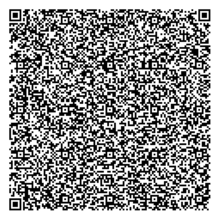 Version 25 (117×117 enlarged to 640x640)
Version 25 (117×117 enlarged to 640x640)
-
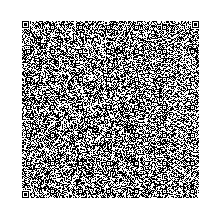 Version 40 (177×177). Content: 1,264 characters of ordinary/ASCII text: A description of QR codes taken from an early version of this Misplaced Pages article
Version 40 (177×177). Content: 1,264 characters of ordinary/ASCII text: A description of QR codes taken from an early version of this Misplaced Pages article
Error correction
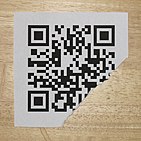

Codewords are 8 bits long and use the Reed–Solomon error correction algorithm with four error correction levels. The higher the error correction level, the less storage capacity. The following table lists the approximate error correction capability at each of the four levels:
| Level L (Low) | 7% of codewords can be restored. |
| Level M (Medium) | 15% of codewords can be restored. |
| Level Q (Quartile) | 25% of codewords can be restored. |
| Level H (High) | 30% of codewords can be restored. |
In larger QR symbols, the message is broken up into several Reed–Solomon code blocks. The block size is chosen so that at most 15 errors can be corrected in each block; this limits the complexity of the decoding algorithm. The code blocks are then interleaved together, making it less likely that localized damage to a QR symbol will overwhelm the capacity of any single block.
Thanks to error correction, it is possible to create artistic QR codes that still scan correctly, but contain intentional errors to make them more readable or attractive to the human eye, as well as to incorporate colors, logos, and other features into the QR code block.
Encoding
The format information records two things: the error correction level and the mask pattern used for the symbol. Masking is used to break up patterns in the data area that might confuse a scanner, such as large blank areas or misleading features that look like the locator marks. The mask patterns are defined on a grid that is repeated as necessary to cover the whole symbol. Modules corresponding to the dark areas of the mask are inverted. The format information is protected from errors with a BCH code, and two complete copies are included in each QR symbol.
The message dataset is placed from right to left in a zigzag pattern, as shown below. In larger symbols, this is complicated by the presence of the alignment patterns and the use of multiple interleaved error-correction blocks.
-
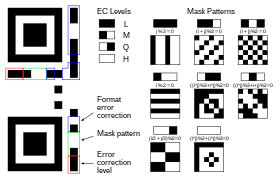 Meaning of format information
Meaning of format information
-
 Message placement within a QR symbol
Message placement within a QR symbol
-
 Larger symbol illustrating interleaved blocks
Larger symbol illustrating interleaved blocks
Four-bit indicators are used to select the encoding mode and convey other information. Encoding modes can be mixed as needed within a QR symbol.
| Indicator | Meaning |
|---|---|
| 0001 | Numeric encoding (10 bits per 3 digits) |
| 0010 | Alphanumeric encoding (11 bits per 2 characters) |
| 0100 | Byte encoding (8 bits per character) |
| 1000 | Kanji encoding (13 bits per character) |
| 0011 | Structured append (used to split a message across multiple QR symbols) |
| 0111 | Extended Channel Interpretation (select alternate character set or encoding) |
| 0101 | FNC1 in first position (see Code 128 for more information) |
| 1001 | FNC1 in second position |
| 0000 | End of message |
After every indicator that selects an encoding mode is a length field that tells how many characters are encoded in that mode. The number of bits in the length field depends on the encoding and the symbol version.
| Encoding | Ver. 1–9 | 10–26 | 27–40 |
|---|---|---|---|
| Numeric | 10 | 12 | 14 |
| Alphanumeric | 9 | 11 | 13 |
| Byte | 8 | 16 | 16 |
| Kanji | 8 | 10 | 12 |
Alphanumeric encoding mode stores a message more compactly than the byte mode can, but cannot store lower-case letters and has only a limited selection of punctuation marks, which are sufficient for rudimentary web addresses. Two characters are coded in an 11-bit value by this formula:
- V = 45 × C1 + C2
| Code | Character | Code | Character | Code | Character | Code | Character | Code | Character |
|---|---|---|---|---|---|---|---|---|---|
| 00 | 0 | 09 | 9 | 18 | I | 27 | R | 36 | SP |
| 01 | 1 | 10 | A | 19 | J | 28 | S | 37 | $ |
| 02 | 2 | 11 | B | 20 | K | 29 | T | 38 | % |
| 03 | 3 | 12 | C | 21 | L | 30 | U | 39 | * |
| 04 | 4 | 13 | D | 22 | M | 31 | V | 40 | + |
| 05 | 5 | 14 | E | 23 | N | 32 | W | 41 | – |
| 06 | 6 | 15 | F | 24 | O | 33 | X | 42 | . |
| 07 | 7 | 16 | G | 25 | P | 34 | Y | 43 | / |
| 08 | 8 | 17 | H | 26 | Q | 35 | Z | 44 | : |
Decoding example
The following images offer more information about the QR code.
License
The use of QR codes is free of any license. The QR code is clearly defined and published as an ISO standard.
Denso Wave owns the patent rights on QR codes, but has chosen not to exercise them. In the USA, the granted QR code patent is US 5726435 , and in Japan JP 2938338 . The European Patent Office granted patent "EPO 0672994". to Denso Wave, which was then validated into French, UK, and German patents, all of which are still in force as of November 2011.
The word QR code itself is a registered trademark of Denso Wave Incorporated. In UK, the trademark is registered as E921775, the word "QR Code", with a filing date of 03/09/1998. The UK version of the trademark is based on the Kabushiki Kaisha Denso (DENSO CORPORATION) trademark, filed as Trademark 000921775, the word "QR Code", on 03/09/1998 and registered on 6/12/1999 with the European Union OHIM (Office for Harmonization in the Internal Market). The U.S. Trademark for the word "QR Code" is Trademark 2435991 and was filed on 29 September 1998 with an amended registration date of 13 March 2001, assigned to Denso Corporation.
Variants
Micro QR code is a smaller version of the QR code standard for applications where symbol size is limited. There are 4 different versions (sizes) of Micro QR codes: the smallest is 11×11 modules; the largest can hold 35 numeric characters.
Model 1 QR code is an older version of the specification. It is visually similar to the widely seen model 2 codes, but lacks alignment patterns.
-
 Micro QR code example
Micro QR code example
-
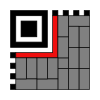 Micro QR code functional regions
Micro QR code functional regions
-
 Model 1 QR code example
Model 1 QR code example
-
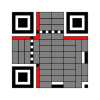 Model 1 QR code functional regions
Model 1 QR code functional regions
Risks
The only context in which common QR codes can carry executable data is the URL data type, which may carry Javascript, but is only supposed to be executed in a regular browsing context, therefore carrying only minimal risk of abuse (no more than opening any web page). However, QR codes may be used to exploit flaws in other applications on the host system, such as the reader, the browser or the image viewer, since a reader will typically send the data to the application associated with the data type used by the QR code.
Malicious QR codes combined with a permissive reader can put a computer's contents and user's privacy at risk. This practice is known as "attagging", a portmanteau of "attack tagging". They are easily created and can be affixed over legitimate QR codes. On a smartphone, the reader's permissions may allow use of the camera, full Internet access, read/write contact data, GPS, read browser history, read/write local storage, and global system changes.
Risks include linking to dangerous web sites with browser exploits, enabling the microphone/camera/GPS, and then streaming those feeds to a remote server, analysis of sensitive data (passwords, files, contacts, transactions), and sending email/SMS/IM messages or DDOS packets as part of a botnet, corrupting privacy settings, stealing identity, and even containing malicious logic themselves such as JavaScript or a virus. These actions could occur in the background while the user is only seeing the reader opening a seemingly harmless web page. In Russia, a malicious QR code caused phones that scanned it to send premium texts at a fee of US$6 each.
Print size
It is recommended that the minimum size for a printed QR code should be 0.03 inches (0.76 mm) square for a single "module", ie. one "bit" of the code. A minimum of four modules width should be left blank around the code.
See also
References
- "QR Code features". Denso-Wave. Archived from the original on 15 September 2012. Retrieved 3 October 2011.
- ^ "QR Code Essentials". Denso ADC. 2011. Retrieved 12 March 2013.
- Borko Furht (2011). Handbook of Augmented Reality. Springer. p. 341.
- ^ "QR Code — About 2D Code". Denso-Wave. Archived from the original on 15 September 2012. Retrieved 3 October 2011.
- ^ "QR Code Standardization". QR Code.com. Denso-Wave. Archived from the original on 15 September 2012. Retrieved 23 April 2009.
- "AIM Global Online Store". Aimglobal.org. Archived from the original on 15 September 2012. Retrieved 23 April 2009.
- "Synchronization with Native Applications". NTT DoCoMo. Archived from the original on 5 September 2012. Retrieved 17 February 2009.
- "Barcode Contents". zxing – A rough guide to standard encoding of information in barcodes. Archived from the original on 30 May 2012. Retrieved 17 February 2009.
- Tolliver-Walker, Heidi (2011). "Making Best Use of QR codes: Gleaning Lessons from the Latest Data". Seybold Report: Analyzing Publishing Technologies. 11 (23): 2–7.
- "http://www.mobilemarketer.com/cms/news/software-technology/11930.html". Archived from the original on 12 September 2012.
{{cite web}}: External link in|title= - "http://blogs.vancouversun.com/2012/01/04/tescos-cool-qr-code-advertising-campaign/". Archived from the original on 20 July 2012.
{{cite web}}: External link in|title= - "Google Chart Tools". Archived from the original on 7 July 2012.
- "QR Code Readers for iPhone, Android, Blackberry and Windows Phone 7". Archived from the original on 18 July 2012.
- "Geo Tagged QR Codes". Archived from the original on 14 July 2012. Retrieved 27 October 2011.
- "QR codes on China's train tickets may leak personal information". Want China Times. Retrieved 16 March 2013.
{{cite news}}:|first=missing|last=(help) - ^ "How to jazz up your CV with QR codes - The Times of India". The Times Of India.
- "World's first QR code coin website". Archived from the original on 15 September 2012.
- Novak, Asami (23 March 2008). "Japanese Gravestones Memorialize the Dead With QR Codes". Wired. Retrieved 8 May 2013.
- "package overview for mbarcode". Maemo.org. Archived from the original on 11 July 2012. Retrieved 28 July 2010.
- "QR Codes for Marketing: A Unique Way to Bridge Offline and Online Media". Human Service Solutions, LLC. 2011. Retrieved 12 March 2013.
- "16 August 2011". Archived from the original on 6 September 2012.
- "Tesco QR Code Virtual Store". Archived from the original on 15 September 2012.
- "Marketing futurista: ya se puede comprar con la cámara del celular". Archived from the original on 15 September 2012.
- "11 November 2010". Archived from the original on 15 September 2012.
- "Top 10 QR Code Store examples". Archived from the original on 15 September 2012.
- "SCVNGR Unveils QR Code Payment System".
- "MasterCard starts piloting QkR mobile payment app".
- "Standard No. 26: Format for exchanging the payment information for Czech domestic payments using the QR codes". Czech Banking Association. November 2012.
- http://bitcoin.org/en/faq
- https://blockchain.info/wallet/features
- "Google testing login authentication via QR codes".
- お墓参りも「ネット」の時代 携帯サイトで故人を偲ぶ
- QR code graves give a “Memorial Window”
- 供養の窓 - 石の声 株式会社
- Quiring Monuments adds smartphone codes to gravestones
- "Uruguayan Jewish Cemetery QRfied". EL PAIS. 24 March 2014. Template:Es icon
- "QR Droid". Google. 19 August 2011. Retrieved 5 September 2011.
- "Encrypted QR Codes". QR Droid. 24 October 2011. Retrieved 5 September 2011.
- "QR Code Usage In Japan". Studio Cliffano. 18 May 2009. Retrieved 18 May 2009.
- "Version and Maximum capacity table". Denso-Wave. Archived from the original on 15 September 2012.
- "2D Barcode: QR-Code". Archived from the original on 15 September 2012. — TEC-IT
- Orli Sharaby (18 October 2010). "Form Meets Function: Extreme Makeover QR Code Edition". Archived from the original on 8 July 2012. Retrieved 29 July 2011.
- Hamilton Chan (18 April 2011). "HOW TO: Make Your QR Codes More Beautiful". Archived from the original on 10 July 2012. Retrieved 29 July 2011.
- "QR Code.com". Denso-Wave. 6 November 2003. Archived from the original on 15 September 2012. Retrieved 23 April 2009.
- "UK QR Code Trademark". Archived from the original on 15 September 2012.
- "EU QR Code Trademark". Archived from the original on 15 September 2012.
- "US QR Code Trademark". Archived from the original on 15 September 2012.
- Information technology — Automatic identification and data capture techniques — QR Code 2005 bar code symbology specification, ISO/IEC 18004:2006 cor. 2009, pages 3, 6.
- ^ "Jargon Watch", Wired, vol. 20, no. 1, p. 22, January 2012.
- "Malicious Images: What's a QR Code". SANS Technology Institute. 3 August 2011. Archived from the original on 13 July 2012. Retrieved 31 August 2011.
- "Barcode Scanner". Google. 1 June 2011. Archived from the original on 15 September 2012. Retrieved 31 August 2011.
- "QR Droid". Google. 19 August 2011. Archived from the original on 15 September 2012. Retrieved 31 August 2011.
- "ScanLife Barcode Reader". Google. 24 May 2011. Archived from the original on 15 September 2012. Retrieved 31 August 2011.
- "Consumer Alert: QR Code Safety". Better Business Bureau. 23 June 2011. Archived from the original on 15 July 2012. Retrieved 31 August 2011.
- "AVG Cautions: Beware of Malicious QR Codes". PC World. 28 June 2011. Archived from the original on 7 September 2012. Retrieved 31 August 2011.
- "EvilQR – When QRCode goes bad". AppSec-Labs Blog. 14 August 2011. Archived from the original on 15 September 2012. Retrieved 31 August 2011.
- "QR Codes: A Recipe for a Mobile Malware Tsunami". Cyveillance, Inc. 20 October 2010. Archived from the original on 28 July 2012. Retrieved 31 August 2011.
- QR Codes hold up to 2.9 KB whereas the smallest known computer virus is about one-tenth that size "The Smallest Virus I Could Manage". Virus Labs and Distribution. 1995. Archived from the original on 15 September 2012. Retrieved 31 August 2011.
- "Beware of Malicious QR Codes". ABC. 8 June 2011. Archived from the original on 1 August 2012. Retrieved 31 August 2011.
- How big does a QR code need to be?
Bibliography
- BS ISO/IEC 18004:2006. Information technology. Automatic identification and data capture techniques. Bar code symbology. QR Code. Geneva: ISO/IEC. 2000. p. 114.
- BS ISO/IEC 18004:2006. Information technology. Automatic identification and data capture techniques. QR Code 2005 bar code symbology specification. London: BSI. 2007. p. 126. ISBN 978-0-580-67368-9.
External links
- Official website
- Reed Solomon Codes for Coders – an elaborate tutorial on Wikiversity, covering both QR code structure and the Reed Solomon codes used to encode the data.
- J. D. Biersdorfer (2 March 2011). "Q&A: how to Make a Quick Response Code". The New York Times. Retrieved 11 December 2012.
{{cite news}}: Italic or bold markup not allowed in:|publisher=(help) Information on converting a URL into a QR code - Adrian Lew (4 March 2014). "Q&A: how to Make a Logo Quick Response Code". LogoQRcode. Retrieved 1 March 2014.
{{cite news}}: Italic or bold markup not allowed in:|publisher=(help) Information on converting a URL into a QR logo code
| Barcodes | ||||||
|---|---|---|---|---|---|---|
| Linear barcodes |
| |||||
| Post office barcodes | ||||||
| 2D barcodes (stacked) | ||||||
| 2D barcodes (matrix) | ||||||
| Polar coordinate barcodes | ||||||
| Other | ||||||
| Technological issues | ||||||
| Other data tags | ||||||
| Related topics | ||||||


